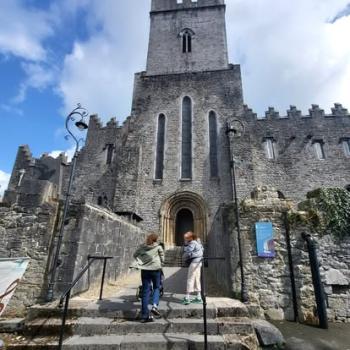
When people use the word “church” today, they are most likely talking about either a building or a worship service. A non-Christian is most likely to think of a “church” as the building where Christian services are held, whereas Christians usually have both meanings in mind. Christians also have a third meaning in mind: the church as a community of fellow believers.
Modern understandings of “church” as a building or a worship service are not how the word was originally used in the Bible. The Greek word from the New Testament that is translated “church” is ekklesia, which means “out-calling” or “assembly of called-out ones.” The word ekklesia or “church” first appears in Matthew 16.18. In this chapter, Jesus had brought his disciples outside Jerusalem and had had a conversation with them about what the people were saying about him. He then asked them, “Who do you say I am?” Simon responded, “You are the Messiah, the Son of the living God.” Jesus then gave Simon his new name, Peter, which means “rock.” This famous exchange finished with Jesus saying, “On this rock I will build my church.” At that point, it is clear that Jesus was not talking about either a particular form of worship or a building, but a community of disciples or an assembly of followers.
Throughout the Scriptures, ekklesia, “church,” is used to refer to groups of Christians. 1 Corinthians 1.2 openly equates “the church of God” with “those who have been sanctified in Christ Jesus and called to be holy.” Many scholars suggest that the summary statement in Acts 2.42 describes the practices of this ekklesia. There we see a group of people who were devoted to “the apostles’ teaching”—that is, they had accepted the Gospel and were learning about Jesus; they joined “the fellowship”—that is, they created community with other believers; they broke bread together—that is, they shared meals and, most importantly, shared the Lord’s Supper; and they prayed. Such practices can take place anywhere and did not need a specific building.
At the time the New Testament was written, Christians did not usually have their own specific places to worship or even a set style of worship. The earliest Christians were almost all Jewish, and they often gathered for worship at the Temple and continued to meet in local synagogues. They also met in homes for further fellowship. Once Christianity began to spread to a non-Jewish audience and created communities all over the Greek and Roman world, believers would meet in homes, public halls, and outdoors.
By the end of the first century, Christians were facing considerable resistance from the authorities. In many places they were persecuted—tortured and executed for their faith. Christians began to meet in back rooms, catacombs, and hidden places due to the threats they faced. Public structures as permanent locations for Christian worship could be built more securely after the conversion of the Emperor Constantine and his Edict legalizing the Christian faith (A.D. 313). Nevertheless, the church as community, the ekklesia, was always the primary reality.
3/23/2021 6:32:40 PM








